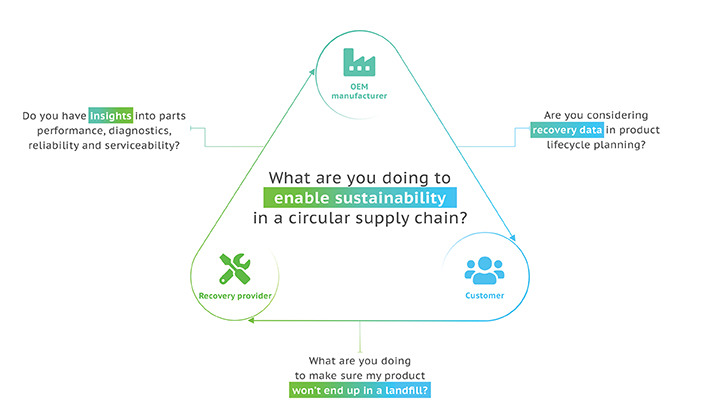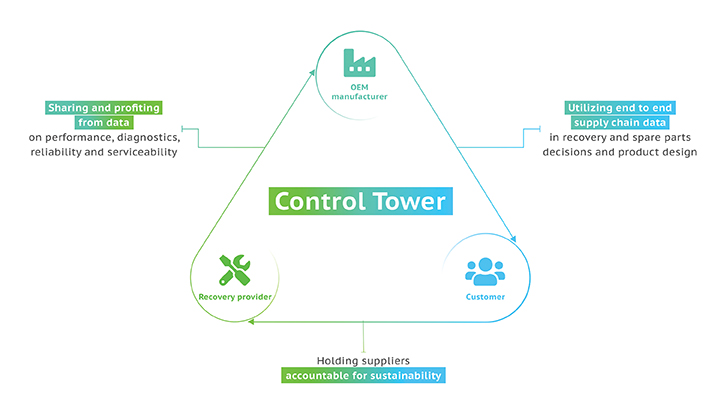Going for Gold: Mining Data to Drive Customer Satisfaction
By Rohit Joshi, Entercoms, Inc.
The circular economy is gaining momentum across many industry verticals. It may seem like a new concept but it’s really not when you consider how we’ve reused and recycled materials instead of discarding them. This movement is not necessarily being driven out of altruistic ideals, it makes financial sense. In the circular ‘supply chain’, convenience comes at a price, particularly in your services group. This article is focused on driving circularity in the service supply chain.
The service supply chain starts where the manufacturing supply chain ends after the product is installed at a customer’s site. The goal of a service supply chain is to ensure that customer uptime commitments are met at an optimal cost by delivering parts and labor. A circular service supply chain can only truly exist if all the functions and partners share data, use technology to analyze that data and incorporate that analysis into business decisions. It’s an important way to effectively reduce waste and inefficiency. Particularly, manufacturers and recovery providers can efficiently achieve sustainability goals, without compromising on service or cost, based on data and collaboration.
Enabling Sustainability: Where do you stand today?
When customers ask you what part you play in enabling a circular service supply chain, what will your answer be?
As an OEM, do you plan for the complete lifecycle of your product to make it sustainable, efficient, repairable, as well as meeting client expectations regarding uptime? Do you have all the data you need to make decisions?
As a recovery service provider, do you have insights into parts failures, diagnostics, reliability and serviceability? What are you doing with this data?
As a customer, do you hold your providers accountable for driving a circular supply chain?
COVID-19 has accelerated digital transformation and laser-focused attention on the availability of data in the supply chain. Reliance on a circular supply chain has brought about new opportunities and business growth as companies look to partner with experts that have proven track record of singularly integrating disparate systems and data to deliver actionable insights.
Service, maintenance, repair and recovery businesses have a lesson learned from COVID-19:
There is no room for waste and inefficiency in providing for essential needs.
What part will you play in enabling the circular economy? What are the actions you can take to start right now?

Enabling a Circular Service Supply Chain: Four actions…
To reduce waste and inefficiency and move towards a circular economy there are four primary enabling actions augmented by data and technology:
Smart Part Selection: Choosing the right part, the first time and every time.
A critical piece of information to consider is known parts performance and diagnostic information gathered during recovery; factors like “no-fault found”, “cannot duplicate error” or identifying specific small components that were failing and repaired.
Let’s talk through an example. If 99% of the time, for certain fault codes, a laptop is repaired by replacing a combination of two parts, but 95% of the time, one of those parts is diagnosed during recovery as perfectly fine, sending the second part out for those fault codes might be wasteful. Is this data available to you? Are these insights incorporated this into your decision making?
In this scenario, the planning team sees demand for the part that has not failed, however, in reality it is a false demand. If the correct data was incorporated into the decision to send the part, then stocking, sending, recovering the perfectly fine part could have been avoided.
Another enablement action is utlizing part substitutions effectively. Common part chaining can identify known part substitutions. Wiith technology, non-obvious cross-technology part matches can be identified and proven substitutes provided for the repair.
If recovery & diagnostic data indicated a better performing substitute within the part chain, client satisfaction would dictate utilizing the more reliable part. If multiple parts could fix the customer’s issue, now you can factor in price and cost to decide which part to ship. This takes into consideration the data in the entire supply chain data when choosing a part to make the correct decision for your organization and customers.
From a service provider or OEM’s perspective, part waste and overstocking can be reduced by picking the right part, the first time and every time. This increases customer satisfaction while at the same time removing unnecessary expense.
Anticipate Needs: Dynamic analysis of service installed base.
Understanding your service installed base, including the locations of the assets, service-level obligations and most critically, failure predictions, allows you to optimize parts stocking.
To identify the appropriate parts and skills to service an asset, the components must be known. You must get down to the specific list of components and replacement parts, unless you want to invest in stocking every part in your bill of materials across all your locations.
If service parts are located on opposite sides of a country, a 4-hour service-repair objective may be impossible to meet, repair may be delayed, and your customer will certainly not be pleased. Equally critical is the contracted service level agreement (SLA). Network optimization can then utilize algorithms to determine the best location to stock parts to service assets most efficiently, reducing cost and ensuring SLAs are met.
Predictive analytics takes an enormous amount of data elements and uses machine learning and cognitive analytics to predict failures. This leads to efficient demand planning for parts, meeting SLAs and satisfied customers. Predictive analytics can also enable proactive repair actions. Parts and labor can be planned for these service calls in a cost-effective manner. The alternative might involve a field engineer call-out and overnighting a part at much higher cost. Predicting failures is critical to long term service plan success. To effectively predict these failures, recovery data is critical: Diagnostic information, repair actions, and small-component replacement all play into predicting failures.
Tying parts stocking to the installed assets, along with predicted failures, avoids waste by only stocking parts that will be utilized. Optimizing your parts network will result in efficiently meeting client demand without wasting, labor, transportation & warehouse costs and excess inventory.

Dynamic Recovery: Planning, analytics and intelligent goals.
OEMs set return and repair rate goals for used parts. Key to understanding the performance is verifying the return and repair of parts are realistic, achievable and being met.
What if data could make those goals smarter? If you know a certain part number will only yield a 70% return rate and a 50% repair yield over time, then you know it will never match up to a 90% recovery goal. If your recovery planning is based on arbitrary estimates instead of actual data, how do you make efficient decisions on when to buy new or rely on repair? How do you set dynamic targets for recovery based on supply and demand situations at the part number level?
There are many considerations for deciding what to do with a single part. With the eye on optimizing reserves and reducing new buys, you must account for repair lead times, capacity and pricing.
You can anticipate when & where parts will be required, if demand is effectively predicted. If lead times do not meet the supply requirements, additional sourcing or new buy will need to be considered to prevent negative impact to customer satisfaction.
Repair service providers have limited capacity. If demand analytics indicate additional parts will be required to service customers, parts will have to be sourced. Pricing analysis then becomes critical as there is a trade-off to purchasing new rather than repairing used parts. Repairing parts may still prove more economical as long as the repair yield is realized and there is no impact to the customer SLA.
AI and machine learning-based solutions enable dynamic modeling based on business goals to help you understand potential impact to the customer, inventory and cost. The automated intelligence will learn your business over time and will make the recommendations and adjustment based on your business rules.
Control Tower: Consolidating data and controlling your service supply chain.
To optimize performance and part availability, disparate data, from multiple systems and multiple partners across the service supply chain, needs to be consolidated and at your fingertips. A control tower provides end-to-end visibility of the supply chain, and when partnered with workflow management, it assigns appropriate control and ownership of decision making. Efficiency in task ownership and prioritization reduces wasted effort and appropriately leverages control points of risks.
Data and Collaboration: Critical enabler to the circular supply chain.
Most companies’ service supply chains are fragmented. There is little sharing of information across the supply chain end-to-end. The repair industry has evolved based on unique service needs and not synergistically as a whole. You may not want partners to know the minute detail of how and what you repair, but this is where change is required.
As a recovery service provider, why should you share data? To put it bluntly, you’re leaving money on the table by not pricing provision of repair data into your services. If it fits your business model, offering a separate data deliverable is an option. This repair data is your goldmine, your value and your differentiator.
OEMs require data to consider the lifecycle of products being developed. Customers want sustainable assets and parts that can be effectively utilized during their product lifecycle. As part of the circular supply chain, OEMs must consider the impact of recovery data on production, uptime performance, serviceability, re-use, and recyclability - customer satisfaction is your goldmine!
AI, machine learning and other emerging technologies are radically changing the need for data in the circular supply chain. Every industry has been through an innovation growth cycle. These types of technology are being applied to retail and consumer spaces, oil and gas, information technology, datacenters, and virtually any industry. AI is everywhere and growing.
Collaboration between manufacturers, OEMs and recovery providers is required. Use of technology to incorporate data in this collaboration is critical and is the circular supply chain’s goldmine!
Start mining!
For OEMs, to enable a truly circular economy, focused on sustainability, customer satisfaction, uptime, and cost, the time is now to start utilizing recovery data effectively and to plan for the total lifecycle of a product.
For recovery providers, don’t be left behind! Consider this, if any single recovery provider in this industry starts providing recovery data as a service, you are left being a commodity. Without differentiating yourself from other commodity partners, will your business still be able to compete? Maybe you’ve never considered that recovery data is an untapped goldmine? Your best kept secret is now your most marketable asset and differentiator.
Entercoms has developed solutions for service supply chains utilizing the goldmine of service supply chain data. These solutions help to achieve your customer uptime commitments at the optimal cost, and help you move toward a circular, automated, AI-driven and predictive service supply chain. These solutions are in use today and widely trusted to modernize your service supply chain.
Here’s your tap on the shoulder from the future. Time to start mining.
It’s time for this industry to shift. To collaborate. To adapt and evolve. To infuse AI. To leverage service supply chain data as an asset.
It’s essential.
 Rohit Joshi
Rohit JoshiRohit Joshi is a Sr.VP of Supply chain transformation at Entercoms with extensive experience in leading and transforming supply chains to improve customer experience and reduce cost. Rohit is passionate about helping supply chains realize their full potential through process improvement, data analytics and digitization. He can be reached at rohit.joshi@entercoms.com